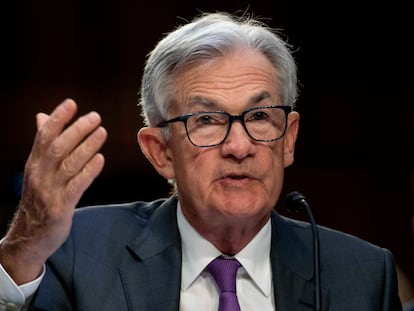The global battle against inflation drags on
Central bankers prepare to keep interest rates high for longer than expected


Central bankers are always in search of a compass. This is because they’re sailing by the stars while the sky is cloudy. Federal Reserve Chairman Jerome Powell offered up this metaphor in Jackson Hole, Wyoming this past Friday, at the Economic Symposium. Following the pandemic and the outbreak of the war in Ukraine, the rules of the game have changed: there’s no instruction manual for what’s happening, according to Christine Lagarde, president of the European Central Bank (ECB).
The battle against inflation is dragging on, with rising prices threatening a less globalized world. Obstacles to contend with include bottlenecks in the supply change, shortages of some essential raw materials and climate change. The question is now longer so much how high rates will rise, but rather how long they’ll remain high. The era of cheap money that followed the Great Recession is over, and it doesn’t look like it’s coming back anytime soon. This will have many consequences for mortgages, investment and the economy in general.
While central bankers try to find their compass, the big central banks — and especially the Federal Reserve — prefer to err in the direction of price stability, even if that means having to navigate through a recession. Central bankers fall into the categories of “hawks” — those concerned about price stability at all costs — and “doves,” being the ones who are more sensitive to high levels of unemployment. Robert McTeer, the former president of the Dallas Federal Reserve Bank, notes that “only hawks go to central banker heaven.” Perhaps Powell and Lagarde are trying to earn their place in heaven by taking on the highest inflation in four decades.
Jackson Hole may not be heaven, but at the end of August, it looks like it. This idyllic enclave in the Rocky Mountains — nestled in the heart of Wyoming’s Grand Teton National Park — suffers from rough winters, but also enjoys mild summers that contrast with the humid heat that grips Washington, D.C. For more than 40 years, at the invitation of the Kansas City Federal Reserve, Jackson Hole has hosted an economic symposium every year around the end of August, bringing together central bankers and economists from all over the world in a secluded hotel with rustic decoration, including a stuffed bear.
The most anticipated speech was Powell’s. When he delivered it last Friday, he noted that inflation was still “too high” and he was willing to raise rates further if necessary, but clarified that any decision would be made “carefully.” Additionally, he admitted that the rise in rates that has taken place over the past year-and-a-half (from almost 0% to a range of 5.25%-5.5%) will have delayed effects that are yet to unfold. The translation is that the Federal Reserve will pause on September 20 — and perhaps also in November and in December — to decide if another twist is needed, or if enough is enough, according to market sources. But there’s certainly division. Analysts at Bank of America remain comfortable with their forecast that the last 0.25-point-rise will be in November, while those at Oxford Economics believe that the hike this past July was the last.
Lagarde gave fewer clues. However, the comments made by ECB advisers in Jackson Hole over the course of the two-day-long summit foreshadow a battle in September, between those in favor of raising rates even more and those who would prefer to wait. “For me, it’s too early to think about a pause,” opined Joachim Nagel –— the president of Bundesbank — during an interview with Bloomberg TV in Jackson Hole. “We mustn’t forget that inflation continues to hover around 5%. Therefore, it’s too high. Our goal is 2%. So, there’s still a way to go.” Nagel rejected the caricature of Germany as Europe’s sick man at this juncture. “I remain quite optimistic that we will have a soft landing.”
“Soft landing” — a term derived from the space race between the United States and the Soviet Union in the 1970s — is the mantra of central banks when the economy overheats or inflation gets out of hand. It’s about controlling prices with rate hikes, without causing a recession. Alan Greenspan did it at the Federal Reserve in 1994, but he couldn’t prevent a recession after rate hikes helped burst the tech bubble. Powell is trying to achieve a soft landing, but it’s too soon to claim victory. According to Esther George — president of the Kansas City Federal Reserve Bank until last January — next year will be a good time to “pass judgement” on his tenure. Meanwhile, Chicago Federal Reserve Chairman Austan Goolsbee has told CNBC that he sees a “golden path” ahead to reduce inflation without triggering a major recession.
Central bankers have rejected the siren songs of those calling for raising the inflation target from 2% to 3%. This, according to them, would be like cheating. “2% is and will continue to be our inflation target,” Powell said bluntly on Friday. “We will not lose sight of our goal. We must maintain — and we will maintain — inflation at 2% in the medium term,” Lagarde seconded. “It makes me uncomfortable declaring victory when we clearly haven’t won. Before getting into this, we already said what the objective was going to be. You can’t change the inflation target until it’s reached,” Goolsbee added.
What has risen, according to economists, is the neutral interest rate, which neither slows down nor drives the economy. That may explain why rate hikes have cooled activity less than was expected a year ago, even though central bankers have been more aggressive than expected. Factors such as the expansionary fiscal policy (with more deficit and debt) and the savings pools accumulated during the pandemic have obviously raised the neutral interest rate, but even Powell isn’t clear where it stands: “We cannot identify the neutral interest rate with certainty, so there’s always uncertainty about the exact level of monetary policy tightening,” he admitted on Friday.
After the rate hikes of 2022 and 2023, the time has come to calibrate the latest movements. The tradition has been to get the last hike wrong, partly by choice. “Not raising rates enough would be a worse mistake than raising rates too much, because we can fix [the latter],” Cleveland Federal Reserve President Loretta Mester told Bloomberg TV in Jackson Hole. “We have to be very careful. We don’t want to push too hard. We don’t want to come up short,” she added, when interviewed by CNBC. “The risks are now really on both sides: doing too little or doing too much, but I would still err on the side of raising rates,” agreed Martins Kazaks, governor of the Bank of Latvia.
By leaving open the possibility of further rate hikes, Powell is delaying the next debate: when the cuts will start. The current evolution of the interest rates of U.S. bonds likely means that they aren’t on the horizon. “‘Higher for longer’ is the somewhat muted message I’ve received from Jackson Hole,” wrote Bill Gross on X (previously Twitter). He is known as “the king of bonds” and the co-founder of the American investment management firm Pimco.
“We will assess how long to maintain the restrictions as inflation comes down. The real interest rate (nominal inflation-adjusted rates) will tighten, so we’ll have to watch that as we go along,” Mester said. “I think it’s very likely that we’ll need to hold for a considerable amount of time,” Boston Federal Reserve President Susan Collins affirmed. Other participants believe that this is the message for now, but that, for practical purposes, it’s not very relevant. Rather, it will be data that marks future decisions. “Just as inflation surprised [us by ticking] upwards, it can surprise us [by going down],” one of the attendees — who preferred to remain unnamed — told EL PAÍS.
The president of the Federal Reserve Bank of Philadelphia, Patrick Harker — a strong supporter of pausing rate hikes — believes that there will be no rate cuts “clearly until next year at the earliest.” “And when next year? The data will let us know. If the inflation rate falls faster than anticipated, we could cut sooner rather than later… but I think we have to let that happen first,” he told CNBC.
The market is still expecting some rate cuts next year. Bank of America forecasts a drop of 0.75 points for the year as a whole, 0.25 in June and the same in the third and fourth quarters. According to the bank’s analysts, Powell’s speech had a part for the hawks — when he noted that inflation is still “too high” and that he’s willing to raise rates again — and another for the doves, when he explained that the consequences of the rate hikes haven’t been fully felt yet, cautioning that future movements will be made carefully.
Powell has insisted that he doesn’t want to repeat the mistakes of the 1970s, when Federal Reserve Chairman Arthur Burns claimed victory prematurely and inflation became entrenched in the U.S. economy for a decade. Paul Volcker — who held the position from 1979 to 1987 — decided shortly after assuming office to undertake a major change in American monetary policy: restrict the amount of money and have the market set the rates, which reached up to 20%. Volcker was the president of the Fed who attended the first symposium in Jackson Hole, in 1982. There, he found nothing but an avalanche of criticism.
Time, on the other hand, proved Volcker right. Powell has even declared himself to be a great admirer of his. Now, he wants to follow Volcker’s example and “stick with it until the job is done” — a catchphrase inspired by his predecessor, which he repeats over and over again.
Sign up for our weekly newsletter to get more English-language news coverage from EL PAÍS USA Edition
Tu suscripción se está usando en otro dispositivo
¿Quieres añadir otro usuario a tu suscripción?
Si continúas leyendo en este dispositivo, no se podrá leer en el otro.
FlechaTu suscripción se está usando en otro dispositivo y solo puedes acceder a EL PAÍS desde un dispositivo a la vez.
Si quieres compartir tu cuenta, cambia tu suscripción a la modalidad Premium, así podrás añadir otro usuario. Cada uno accederá con su propia cuenta de email, lo que os permitirá personalizar vuestra experiencia en EL PAÍS.
¿Tienes una suscripción de empresa? Accede aquí para contratar más cuentas.
En el caso de no saber quién está usando tu cuenta, te recomendamos cambiar tu contraseña aquí.
Si decides continuar compartiendo tu cuenta, este mensaje se mostrará en tu dispositivo y en el de la otra persona que está usando tu cuenta de forma indefinida, afectando a tu experiencia de lectura. Puedes consultar aquí los términos y condiciones de la suscripción digital.
More information
Archived In
Últimas noticias
Most viewed
- Reinhard Genzel, Nobel laureate in physics: ‘One-minute videos will never give you the truth’
- Oona Chaplin: ‘I told James Cameron that I was living in a treehouse and starting a permaculture project with a friend’
- Pablo Escobar’s hippos: A serious environmental problem, 40 years on
- Charles Dubouloz, mountaineering star, retires at 36 with a farewell tour inspired by Walter Bonatti
- Why we lost the habit of sleeping in two segments and how that changed our sense of time










































